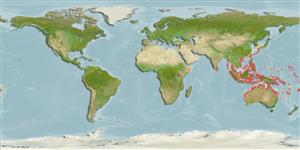Common names from other countries
Classification / Names / Names
Namen | Synonyme | Catalog of Fishes (gen., sp.) | ITIS | CoL | WoRMS
Environment: milieu / climate zone / depth range / distribution range
Ökologie
; tiefenbereich 0 - 20 m (Ref. 348). Tropical
Indo-West Pacific: from India to Melanesia; north Japan and south to Queensland and New Caledonia.
Length at first maturity / Size / Gewicht / Alter
Maturity: Lm ? range ? - ? cm Max length : 9.5 cm SHL Männchen/unbestimmt; (Ref. 348); common length : 7.0 cm Männchen/unbestimmt; (Ref. 348)
Shell solid, medium sized, higher than long, elongate-ovate in outline. Both valves convex, the right (lower) valve more inflated than the left (upper) valve. Ears subequal in size and shape. Right anterior ear with a slight byssal notch anteroventrally, devoid of ctenolium. Outer sculpture of about 10 or 11 rounded radial folds (9 to 13) on each valve, with numerous, much smaller, secondary radial riblets that are set with densely and finely imbricated transverse scales, giving a rather strongly scabrous aspect. Surface of ears with distinct radial ridges (more developed on right anterior ear). Hinge line quite long, about 2/3 of shell length, with shallow marginal ridges. Interior of valves shiny, with a flattened radial sculpture corresponding with the outer folds. Colour: outside of shell off-white to interior satin white, with dark brown on the hinge line.
Attached to rock, coral and other hard objects. Common on coarse sand in coral reef areas. Intertidal and shallow subtidal waters (Ref. 348).
Life cycle and mating behavior
Geschlechtsreife | Fortpflanzung | Ablaichen | Eier | Fecundity | Larven
Members of the class Bivalvia are mostly gonochoric, some are protandric hermaphrodites. Life cycle: Embryos develop into free-swimming trocophore larvae, succeeded by the bivalve veliger, resembling a miniature clam.
Poutiers, J.M. 1998. (Ref. 348)
IUCN Rote Liste Status (Ref. 130435)
CITES Status (Ref. 108899)
Not Evaluated
Not Evaluated
Bedrohung für Menschen
Harmless
Nutzung durch Menschen
| FishSource |
Tools
Internet Quellen
Estimates based on models
Preferred temperature
(Ref.
115969): 25 - 29.3, mean 28.6 (based on 2509 cells).
Verwundbarkeit
Low vulnerability (10 of 100).
